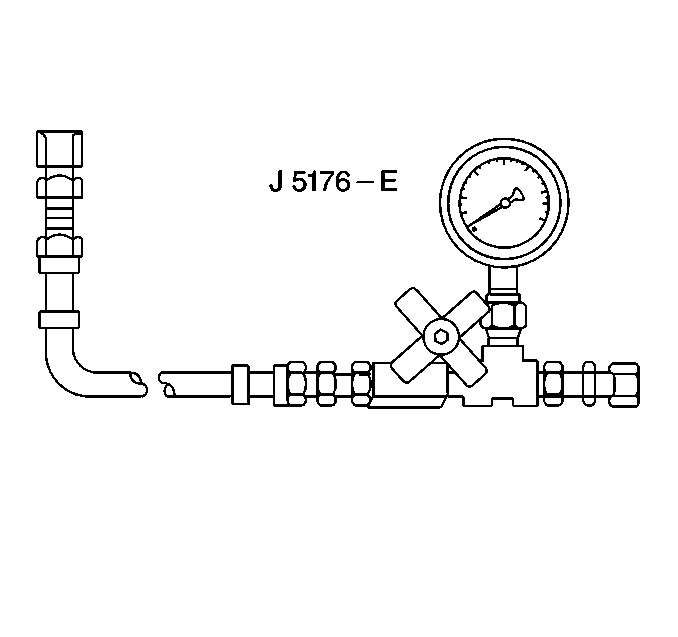
Test the power steering
system using the J 5176-D
as described here. You may also use the J 25323-B
.
- Disconnect the pressure hose at the pump. Use a small container
in order to catch any leaking fluid.
- Connect a spare pressure hose to the pump.
- Connect the J 5176-D
to both hoses.
- Open the valve on the gage.
- Start the engine.
- Allow the system to reach operating temperature.
- Inspect the fluid level. Add fluid if required.
- When the engine is at normal operating temperature, ensure that
the pressure reading on the gage (valve open) is 552-862 kPa
(80-125 psi). If the pressure is greater than 1380 kPa
(200 psi), complete the following steps:
| 8.1. | Examine the hoses for restrictions. |
| 8.2. | Examine the flow control valve for proper assembly. |
- Record a series of pressure reading using the following procedure:
| | Important: Do NOT leave the valve fully closed for more than 5 seconds.
This action may damage the pump.
|
| 9.1. | Fully close the valve. |
| 9.2. | Record the pressure reading each time you close the valve. |
| 9.3. | Perform this procedure 3 times. |
- Ensure that each reading is at least 10 343 kPa
(1,500 psi).
Ensure that the 3 readings are within 345 kPa (50 psi)
of each other.
| • | If the pressure readings are high enough and are within 345 kPa
(50 psi) of each other, the pump is functioning properly. |
| • | If the pressure readings are high enough, but the readings are
not within 345 kPa (50 psi) of each other, the flow control
valve in the pump is sticking. |
| 2. | Clean the valve and remove any burrs using a crocus cloth or a
fine hone. |
| 3. | If the system is contaminated, flush the system. |
| 4. | If the system is exceptionally dirty, then completely disassemble,
clean, and reassemble both the pump and the rack and pinion gear. |
| • | If the pressure readings are less than 10343 kPa (1,500 psi),
replace the flow control valve. Inspect the system. |
| • | If the pressures are still low, replace the rotor and the vanes. |
- If the pump is accurate to specification, perform the following
steps:
| 11.1. | Leave the valve open. |
| 11.2. | Ask an assistant to turn the steering wheel to both stops. |
| 11.3. | Record the highest pressures. |
Compare these pressures with the highest pump pressure that you recorded
in the previous test.
| 11.4. | If the pressure at both stops is not the same as the maximum text
pressure, the rack and pinion is leaking internally. |
Disassemble and repair the rack and pinion.
- Turn off the engine.
- Remove the testing gage and the spare hose.
- Reconnect the pressure hose.
- Inspect the fluid level. Perform any repairs as needed.

